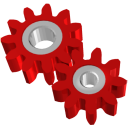 |
LFNAlias Version 1.0 |
|---|---|
| User Guide |
| 1. | Open/run LFNAlias as described under Running LFNAlias from the Windows Desktop | ||||
| 2. | In the Convert Panel press the Browse Button to open the Browse for Files or Folders Dialog | ||||
| 3. | In the Browse for Files or Folders Dialog navigate to your personal, saved pictures folder (under Windows 10, typically C:\Users\Demo User\Pictures\Saved Pictures). | ||||
| 4. | Select an arbitrary file or folder in your saved pictures folder. Ideally the folder or file has a really long name (e.g. somehting like "Me and my family on holiday in Switzerland.jpg") | ||||
| 5. | Close the Browse for Files or Folders Dialog by clicking on its OK Button. Under Windows 10, the Folder/File Path and Name Combo Box in the Convert Panel now ought to contain the following path C:\Users\Demo User\Pictures\Saved Pictures\Me and my family on holiday in Switzerland.jpg | ||||
| 6. |
Click the
Convert Button
on the Convert Panel.
What should have happened, assuming that LFNAlias wann't barred access to the
folder, is that an entry similar to the following was added to the text in the
Output Editor
The DOS, short, 8.3 file name equivalent of the file system path
"C:\Users\Demo User\Pictures\Saved Pictures\Me and my family on holiday in switzerland.jpg" is: C:\Users\DEMO~1\Pictures\SAVEDP~1\MEANDM~1.jpg This is a child folder of the known folder C:\Users\Demo User\Pictures\Saved Pictures with the GUID {3B193882-D3AD-4EAB-965A-69829D1FB59F} |
||||
| 7. | Press the function key F6 on your keyboard. This will list the special folder paths of your operating system, below the text that was added to the Output Editor in the previous step. | ||||
| 8. | Press Ctrl + f on your keyboard to open the Find Panel. | ||||
| 9. | Press Ctrl + pos1 to position the caret at the beginning of the text in the Output Editor. | ||||
| 11. | Enter the name of the user under which you are logged on and/or are running LFNAlias in the Find Panel's Find Combo Box (in the examples so far, this ought to be "Demo User", without the quotation marks). | ||||
| 10. |
Click the
Find Next Button on the Find Panel twice, leaving an approximately one (1) second interval between the clicks.
Once you've clicked on the Find Next Button, two things ought to have happened.
|
||||
| 12. | Select/highlight the entire path (but only the path) in which your user name was found. Normally, this is the path of the file you selected in the Browse for Files or Folders Dialog in step 5. If you have highlighted the path's entire text, the selected path will also be displayed in the Status Bar. | ||||
| 13. | Open the Output Editor's Context Menu by pressing the right mouse button while over the path text, highlighted in the previous step. | ||||
| 14. | Select/click the Open menu item. This will open the selected path in Windows (File) Eploerer. | ||||
| 15. | Select/highlight the short version of the path you opened in the previous step. This is normally the second line, below the path in the long format. Short, 8.3 paths can generally be easily recognized because they often contain tilde "~" characters. | ||||
| 16. | Press the function key F8 on your keyboard. This will open a Windows Command Prompt window, with the marked/highlighed, short, 8.3 path as the working directory/folder. | ||||
| 17. | Open Windows (File) Explorer. | ||||
| 18. | In the Windows File Explorer, you opened in Step 17, open an arbitrary folder on your system drive (typically volume/drive C:), preferably a folder with a name longer than 12 characters. | ||||
| 19. | In Windows File Explorer, select one or more files, with names longer than 8 characters. | ||||
| 20. | While keeping the left mouse button pressed, drag the selected files over the LFNAlias' Main Window's Output Editor and release the mouse button once over the Output Editor. This will drop the files in the Output editor and convert them into their 8.3 name representations. | ||||
| 21. | Close LFNAlias. |
| Topic Hierarchy: LFNAlias • Support • User Guide • Table of Contents • Quick Start |
| See Also: Using LFNAlias, The LFNAlias Main Window, The Browse for Files or Folders Dialog, Save Output Dialog, Tips and Tricks. |
|
Document/Contents version 1.00 Page/URI last updated on 12.04.2023 |
Copyright © Stoelzel Software Technologie (SST) 2010 - 2023 |
Suggestions and comments mail to: webmaster@stoelzelsoftwaretech.com |